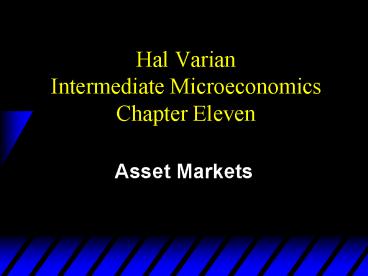Hal Varian Intermediate Microeconomics Chapter Eleven - PowerPoint PPT Presentation
1 / 27
Title:
Hal Varian Intermediate Microeconomics Chapter Eleven
Description:
facilitate trades between people with different levels of impatience ... people (savers) lend funds to impatient people (borrowers) in exchange for a ... – PowerPoint PPT presentation
Number of Views:2373
Avg rating:3.0/5.0
Title: Hal Varian Intermediate Microeconomics Chapter Eleven
1
Hal VarianIntermediate MicroeconomicsChapter
Eleven
- Asset Markets
2
Assets
- An asset is a commodity that provides a flow of
services over time. - E.g. a house, or a computer.
- A financial asset provides a flow of money over
time -- a security.
3
Assets
- Typically asset values are uncertain.
Incorporating uncertainty is difficult at this
stage so we will instead study assets assuming
that we can see the future with perfect
certainty.
4
Selling An Asset
- Q When should an asset be sold?
- When its value is at a maximum?
- No. Why not?
5
Selling An Asset
- Suppose the value of an asset changes with time
according to
6
Selling An Asset
Value
Years
7
Selling An Asset
Maximum value occurs when
That is, when t 50.
8
Selling An Asset
Value
Max. valueof 24,000is reachedat year 50.
Years
9
Selling An Asset
- The rate-of-return in year t is the income earned
by the asset in year t as a fraction of its value
in year t. - E.g. if an asset valued at 1,000 earns 100 then
its rate-of-return is 10.
10
Selling An Asset
- Q Suppose the interest rate is 10. When should
the asset be sold? - A When the rate-of-return to holding the asset
falls to 10. - Then it is better to sell the asset and put the
proceeds in the bank to earn a 10 rate-of-return
from interest.
11
Selling An Asset
The rate-of-return of the asset at time t is
In our example,
so
12
Selling An Asset
The asset should be sold when
That is, when t 10.
13
Selling An Asset
Value
Max. valueof 24,000is reachedat year 50.
slope 0.1
Years
14
Selling An Asset
Value
Max. valueof 24,000is reachedat year 50.
slope 0.1
Sell at 10 yearseven though theassets value
isonly 8,000.
Years
15
Selling An Asset
- What is the payoff at year 50 from selling at
year 10 and then investing the 8,000 at 10 per
year for the remaining 40 years?
16
Selling An Asset
- What is the payoff at year 50 from selling at
year 10 and then investing the 8,000 at 10 per
year for the remaining 40 years?
17
Selling An Asset
So the time at which an asset should besold is
determined by
Rate-of-Return r, the interest rate.
18
Arbitrage
- Arbitrage is trading for profit in commodities
which are not used for consumption. - E.g. buying and selling stocks, bonds, or stamps.
- No uncertainty ? all profit opportunities will be
found. What does this imply for prices over time?
19
Arbitrage
- The price today of an asset is p0. Its price
tomorrow will be p1. Should it be sold now? - The rate-of-return from holding the asset isI.e.
20
Arbitrage
- Sell the asset now for p0, put the money in the
bank to earn interest at rate r and tomorrow you
have
21
Arbitrage
- When is not selling best? WhenI.e. if the
rate-or-return to holding the asset
the interest rate, then keep the asset. - And if thenso sell now for p0.
22
Arbitrage
- If all asset markets are in equilibrium then
for every asset. - Hence, for every asset, todays price p0 and
tomorrows price p1 satisfy
23
Arbitrage
I.e. tomorrows price is the future-value
oftodays price. Equivalently,
I.e. todays price is the present-valueof
tomorrows price.
24
Arbitrage in Bonds
- Bonds pay interest. Yet, when the interest
rate paid by banks rises, the market prices of
bonds fall. Why?
25
Arbitrage in Bonds
- A bond pays a fixed stream of payments of x per
year, no matter the interest rate paid by banks. - At an initial equilibrium the rate-of-return to
holding a bond must be R r, the initial bank
interest rate. - If the bank interest rate rises to r gt r then
r gt R and the bond should be sold. - Sales of bonds lower their market prices.
26
Taxation of Asset Returns
- rb is the before-tax rate-of-return of a taxable
asset. - re is the rate-of-return of a tax exempt asset.
- t is the tax rate.
- The no-arbitrage rule is (1 - t)rb re
- I.e. after-tax rates-of-return are equal.
27
Financial Intermediaries
- Banks, brokerages etc.
- facilitate trades between people with different
levels of impatience - patient people (savers) lend funds to impatient
people (borrowers) in exchange for a
rate-of-return on the loaned funds. - both groups are better off.































